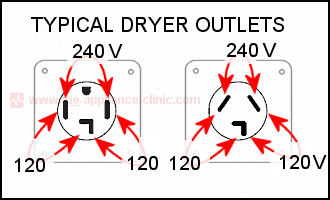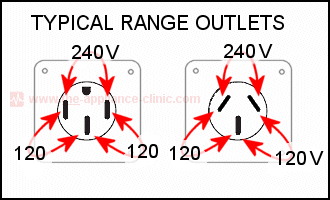Home Page > Troubleshooting and Repair > Maytag 'Dependable Care' Electric Dryer > Power Outlet
Proper Operation
Learn how your appliance is supposed to operate so you can determine if it is malfunctioning.
This page contains affiliate links. For more information visit our
FTC disclosure page.
- Visit our sponsor for parts:

Power Outlet
There are two 120 volt circuits that come into your electric dryer from the big dryer outlet on the wall. This power circuit uses two fuses or breakers in the house fuse panel. There are one of two common types of outlets which could be connected to it. The most popular, older, outlet has an L-shaped slot and the two angled rectangular slots as shown in figure on the left below. The figure on the right shows a 4-terminal dryer plug and matching wall outlet.

Four-wire plugs were first introduced primarily for mobile homes but are now usually standard in all new home construction. If a mobile home resident wanted to make sure that the dryer cabinet was grounded, he had a problem because all the plumbing in his home is plastic and nothing is grounded in the entire trailer! Hence the fourth round ground slot that is connected to a dedicated ground wire from the dryer wall outlet to the breaker box, which is then properly grounded from there. The purpose of the rest of the lugs on the 4-terminal plug are the same as those for a 3-terminal plug, the "L" terminal is neutral and the rectangular terminals carry the two 'hot' 120 VAC circuits.

The neutral of the power supply is connected to the L-shaped slot of the outlet in the figure. It should measure 120 volts from each rectangular slot to the L-shaped slot and 240 volts between the two rectangular slots. The dryer element is connected across that 240 volt circuit. Frequently one of the two 120 volt circuit will open up (0 volts) when there is an overload in the 240 volt heater circuit. The dryer motor, timer and lights, etc. maybe connected across the other 120 volt circuit and therefore the dryer may still run but no heat can be generated.
To check for this situation, measuring the voltage between each rectangular or 'flat' slot in the outlet to the L-shaped slot using a voltmeter set for at least 250 volts alternating current (AC) is necessary. If one leg is much less than 120 volts, but sometimes not zero, one half of the dryer circuit breakers have tripped. If one side has tripped, the voltage between the two rectangular outlets will be around 120 volts instead of 240 volts.
Go to the breaker box and locate the two (2) breakers for the dryer. Switch them both off and then back to on again. If this doesn't restore all of the voltages, the breakers for the dryer may need to be replaced or the wiring between the breaker panel and outlet checked. The breakers for a dryer should be rated 30-ampere. Hire an electrician to install them if needed and if you are uncomfortable messing around in your breaker box. It's a very dangerous place to be if you don't know what you are doing!

On occasion an electric cooking range outlet is used for a dryer. A range type outlet will have a rectangular slot for the neutral terminal of the mating cord instead of the "L" shaped one typically found on dryer cords. While a range outlet and cord's 50 amp rating is well capable of handling a dryer load, it can lead to confusion as to what the circuit is fused at and/or to difficulties when replacing the dryer with a new one. Many new dryers require a cord specially designed for that model and can not just have any old cord installed. You may not be able to find a range cord that will mount on a new dryer to fit your range wall outlet. It's best to use the proper ones for a dryer from the get go.
For help on changing your dryer cord from a 3-terminal plug to a 4-terminal plug, see Changing a Dryer Cord.
Home Page > Troubleshooting and Repair > Maytag 'Dependable Care' Electric Dryer > Power Outlet > How old is my Appliance?
All of the information in these Appliance Clinic procedures is provided FREE OF CHARGE. No liability is assumed by the author for the accuracy of the contents or damages caused by the use of these procedures.

